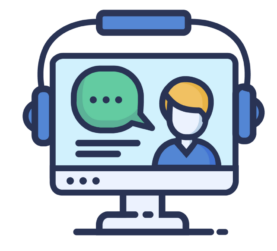The EdTechTeacher Blog
EdTech Resources & Strategies for Teachers
Subscribe to receive updates on our newest blog posts and resources!

by Greg Kulowiec It appears that there are countless options emerging, practically on a daily basis in the Virtual Reality space in education. Yet, there is also a clear disparity between the quality and equitable access to certain types of virtual reality experiences. At scale, schools that have access to virtual reality class kits for consumption are typically working with a Google Expeditions kit (or similar). Quite frequently, when I work with teachers with this setup, there are two problems that emerge: The devices (typically provisioned Android phones) either can’t get onto the school network or are not given access.The…
by: Thomas Daccord A few weeks ago I attended one of Greg Kulowiec’s Augmented Reality and Virtual Reality (ARVR) workshops in the Boston area. Greg did a wonderful job of highlighting ARVR’s educational benefits and I was struck in particular by VR’s implications for Social and Emotional Learning (SEL). Greg drew our attention to a project entitled Becoming Homeless: A Human Experience from the Stanford Virtual Human Interaction Lab. “Becoming Homeless” is a 7-minute VR experience where participants spend days in the life of a person who can no longer afford a home and interact with different environments in an…
A post by EdTechTeacher CEO Tom Daccord Recently I had a conversation with a school director of technology who was wondering how to help teachers identify “entry points” for innovation in their classroom. It made me think of conversations I had on this topic years ago with Dr. Justin Reich of the MIT Teaching Systems Lab in a run-up to a book we were writing together. One approach we both embrace is identifying a “Target of Difficulty.” The idea of a “Target of Difficulty” is finding the intersection of three conditions. First, teachers should seek out parts of their curriculum…
I’ve had the pleasure of working with a wide variety of people in my 24 years as an educator. As a classroom teacher, I always enjoyed collaborating with other teachers, learning from one another. It warmed my heart to teach a colleague something new, and I loved the support of other teachers as they shared new ideas with me. I think that it was the positive feeling of collaboration that led me to being a coach. As I’ve worked with many instructional and digital coaches over the past several years, I’ve not yet found one who went to college thinking,…
By Tom Driscoll (@TomDriscollEDU) I recently had the opportunity to work with an incredible group of elementary educators from Nauset Schools on Cape Cod. We capped off our PBL workshop by designing project sketches that the teachers would implement later this school year. They were so great, I asked the group if they could share their ideas. The teachers generously agreed, and below are their examples of inspiring yet practical examples of project based learning at the K-5 level! 1: Preparing for a Natural Disaster Driving Question How can we, as citizens of a coastal community, prepare for the effects…
Each environment, be it a jungle or a classroom, values certain behaviors and skills over others. So what does the classroom environment that effectively teaches these skills look like? For many, the answer is a classroom built upon the principles of Project Based Learning.
Personalized learning creates a variety of challenges for teachers. Understanding the tools that can support the creation of a personalized path for each student is a key part of making it work. The article focuses on an often overlooked feature in Google forms that can help teachers do just that.
Part 2 of the Deeper Learning Series Written by Tom Driscoll (@TomDriscollEDU) and Dr. Mario Andrade (@mariojandrade) This is the second post in a new 4-part EdTechTeacher series focused on Deeper Learning. Most of the current research and classroom innovation around deeper learning point to a recurring, if not central theme: authenticity and real-world experience. Let’s begin with a quick overview of these findings, then dive into practical resources and technologies that can help us enhance authentic experiences to deeper student learning. Scott McLeod (Different Schools for a Different World 2018) One of the “Four Big Shifts” that Scott McLeod…
Use Immersive Reader on Websites (unofficial) Chrome Extension Technology tools can make accessibility possible by creating embedded supports that differentiate and personalize instruction. The Google Suite has many built-in tools to support students’ reading, writing, and fluency. Extensions for Google Chrome can customize the browsing experience for users. Microsoft’s suite of programs has several learning tools that create an accessible reading experience as well. One such tools is the Immersive Reader. At EdTechTeacher, many of the schools we work with utilize G Suite for EDU as their primary suite of tools. Until recently, I have not been able to find…
Part 1 of the Deeper Learning Series This is the first post in a new 4-part EdTechTeacher series focused on Deeper Learning. How might educators and school leaders design experiences that spark and sustain deeper student learning? As an unprecedented emphasis on deeper learning has developed across the nation, we are tackling this complex challenge with a new level of urgency. Fortunately, new research, frameworks, design resources and practical examples have emerged that can help all of us chart new paths in our own contexts. In this four part series, we will explore the highest quality research and practical resources…
Social Emotional Learning (SEL) is currently a popular focus for schools because evidence suggests that effective SEL improves academic learning. How can we best teach students skills like self-awareness, self- management, empathy, perspective taking and cooperation? Today’s guest is someone who combines her love of reading and knowledge of books to provide support to people trying to start conversations about challenging issues. Whether it’s diversity, mindfulness, diversity or dealing with trauma… she has a list for you. (Though, she also has lists about unicorns and outer space!) Lauren Bercuson shares her work with “Happily Ever Elephants” and how to make…
If Equity work is going to be meaningful, it requires more than just a passing commitment of time and energy, more than just inviting a speaker or distributing materials. It means that community as a whole is going to take a good hard look in the mirror. So what does an Equity process look like and what does it entail? Shawn talks about Equity in Education with Dr. Darnisa Amante of Disruptive Equity Education Project (DEEP)
Educator Kwaku Aning joins us in our first episode that explores the potential and role of virtual reality in education. The discussion covers the entire spectrum of the topic from big picture thinking about the role and impact of VR in the classroom and on student experience, to specific approaches towards implementation.
Have you ever used Google Slides to create images? Just like with Google Drawings, Slides has many tools that facilitate the creation of images. From textboxes to shape and line tools, as well as the ability to change the background or insert photos, Google Slides can be a fabulous tool for teachers to create images to be exported and used in other environments. When I want to create a single, stand-alone graphic or image, I tend to use Google Drawings, but when I want to create a batch of images that are similar – such as images with spelling or…
Personalized learning creates a variety of challenges for teachers. Understanding the tools that can support the creation of a personalized path for each student is a key part of making it work. The article focuses on an often overlooked feature in Google forms that can help teachers do just that.
















